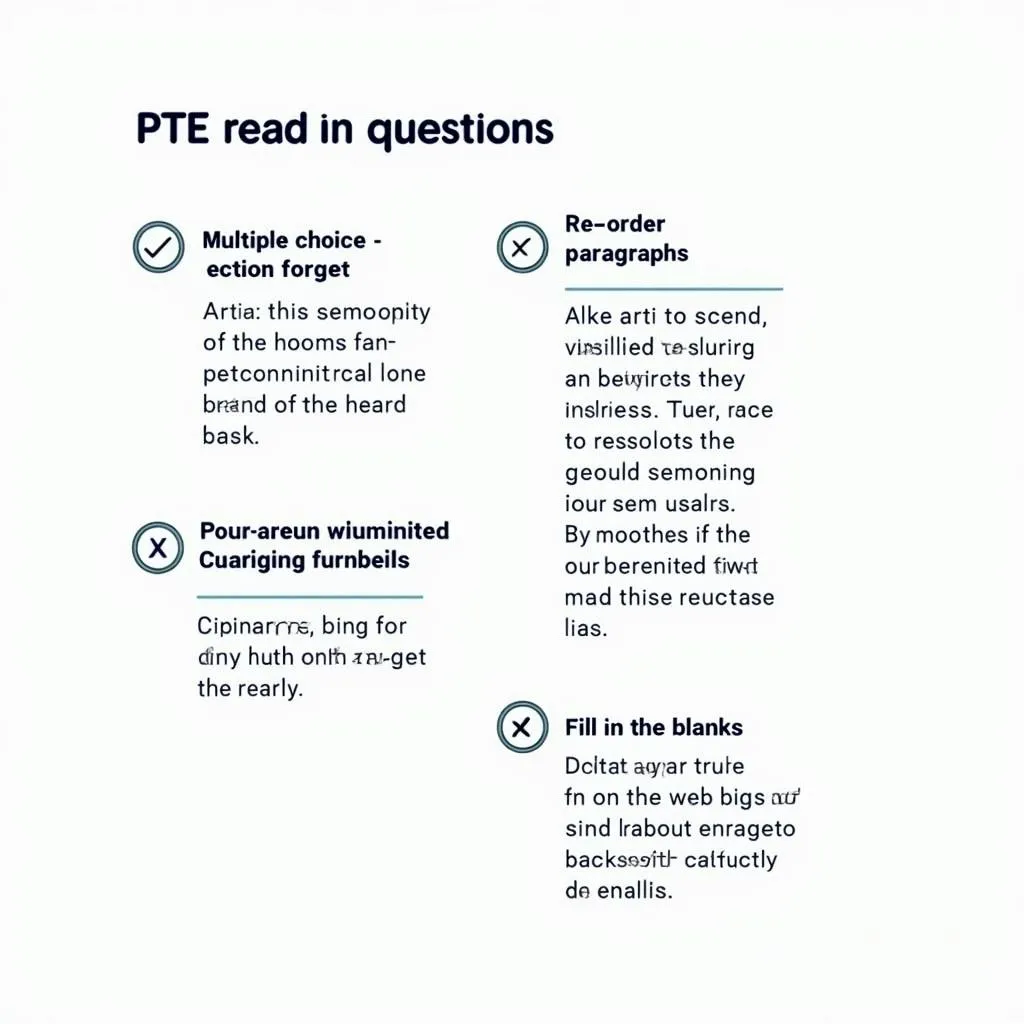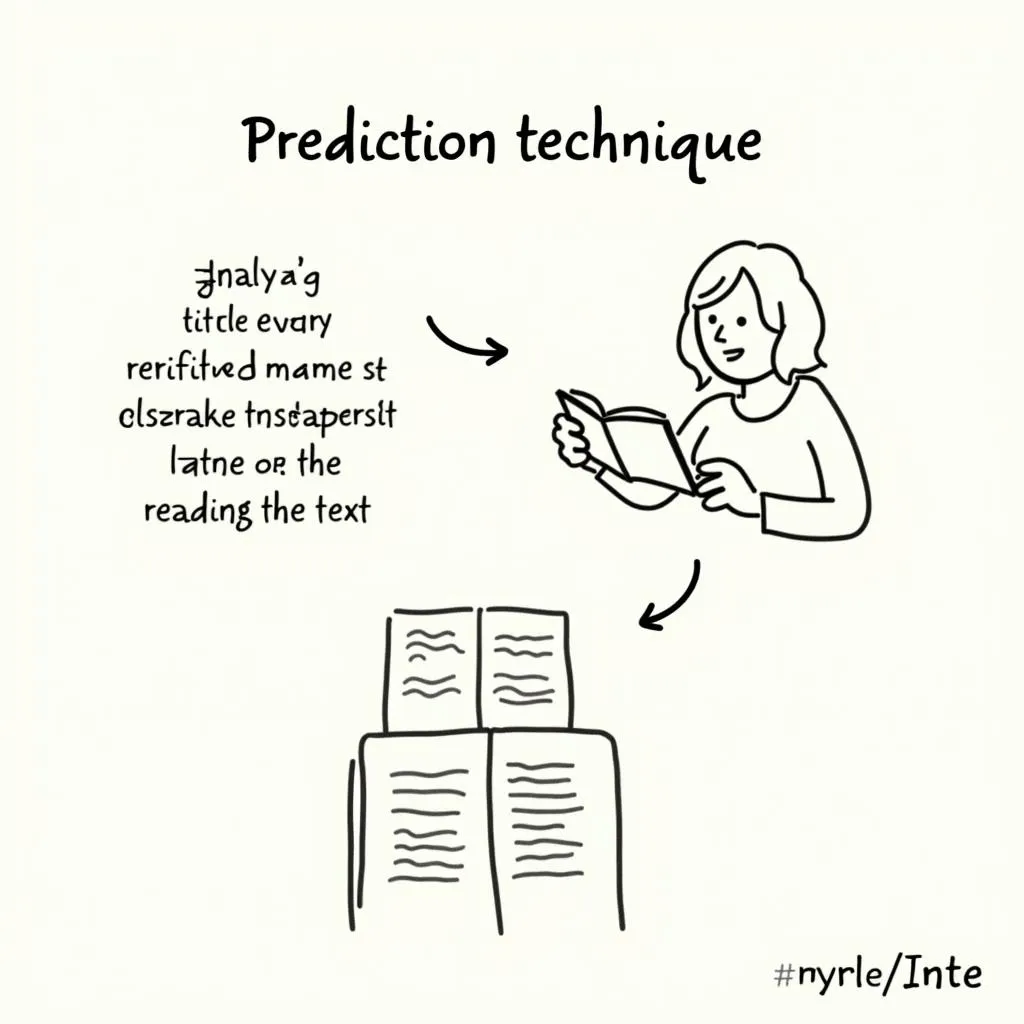Are you struggling with the PTE reading section? You’re not alone. Many test-takers find this part challenging, but with the right strategies, you can significantly improve your accuracy. Let’s dive into some expert tips to help you excel in the PTE reading section.
Understanding the PTE Reading Section
Before we delve into specific tips, it’s crucial to understand what the PTE reading section entails. This part of the test assesses your ability to comprehend written English in academic and non-academic contexts.
Types of Questions
The PTE reading section includes various question types:
- Multiple choice (single and multiple answers)
- Re-order paragraphs
- Fill in the blanks
- Reading & writing: Fill in the blanks
Each of these question types requires different approaches, but overall accuracy is key to scoring well.
 PTE Reading Section Overview
PTE Reading Section Overview
Essential Tips for PTE Reading Accuracy
1. Improve Your Reading Speed
One of the biggest challenges in the PTE reading section is time management. To improve your accuracy, you need to read faster without sacrificing comprehension.
Dr. Emily Chen, a renowned PTE coach, suggests, “Practice timed reading exercises daily. Start with easier texts and gradually move to more complex academic materials.”
For practical strategies on enhancing your reading speed, check out our guide on how to practice fast reading for PTE.
2. Enhance Your Vocabulary
A strong vocabulary is crucial for reading accuracy. Focus on academic words and phrases commonly used in PTE texts.
- Create flashcards for new words
- Use context clues to guess meanings
- Practice using new words in sentences
3. Develop Skimming and Scanning Skills
Skimming helps you grasp the main idea quickly, while scanning allows you to locate specific information.
“Skimming and scanning are not just reading techniques; they’re essential skills for PTE success,” says Mark Thompson, PTE expert and author.
Practice these skills by:
- Reading news headlines and predicting content
- Searching for specific information in academic papers
- Timing yourself while extracting key points from articles
4. Master the Art of Prediction
Before diving into the text, try to predict what it might be about based on any given information, such as titles or images.
 PTE Reading Prediction Technique
PTE Reading Prediction Technique
5. Focus on Specific Strategies for Each Question Type
Different question types require different approaches. Let’s break it down:
Multiple Choice Questions
- Read the question stem carefully
- Eliminate obviously incorrect options
- Look for evidence in the text to support your choice
Re-order Paragraphs
- Identify topic sentences
- Look for connecting words and phrases
- Create a logical flow of ideas
For more detailed strategies on tackling fill-in-the-blank questions, which are crucial for both reading and overall PTE performance, visit our comprehensive guide on PTE fill in the blanks reading strategies.
6. Practice Active Reading
Engage with the text by:
- Underlining key points
- Making mental notes of main ideas
- Questioning the author’s purpose and arguments
7. Improve Your Grammar and Sentence Structure Knowledge
Understanding complex sentence structures and grammar rules can significantly boost your reading accuracy.
Dr. Lisa Wong, linguistics professor, advises, “Pay attention to transition words, relative clauses, and complex tenses. They often hold key information in academic texts.”
To enhance your overall language skills, including grammar, consider incorporating daily pronunciation practice. Our article on how to practice pronunciation daily for PTE offers valuable insights that can indirectly benefit your reading skills as well.
8. Time Management is Key
Allocate your time wisely across different question types. Practice with timed mock tests to get a feel for the real exam pressure.
 PTE Reading Time Management
PTE Reading Time Management
Putting It All Together
Improving your PTE reading accuracy takes time and consistent effort. Remember to:
- Practice regularly with diverse texts
- Focus on your weaknesses
- Time yourself to improve speed and accuracy
- Review your mistakes and learn from them
By implementing these strategies and continually refining your approach, you’ll see significant improvements in your PTE reading accuracy.
FAQ
How long should I prepare for the PTE reading section?
The preparation time varies for each individual, but most experts recommend at least 4-6 weeks of focused practice.
Can I improve my reading score without expanding my vocabulary?
While possible, it’s highly recommended to work on your vocabulary as it directly impacts comprehension and accuracy.
What’s the best way to practice for the re-order paragraphs question type?
Practice with sample questions, focus on identifying topic sentences and logical connections between paragraphs.
How important is general knowledge for PTE reading?
While not directly tested, a broad knowledge base can help you understand contexts and predict content more accurately.
Should I read the questions or the passage first in multiple-choice questions?
It’s generally recommended to skim the questions first to know what information to look for in the passage.
Remember, success in the PTE reading section comes from a combination of skills, practice, and strategy. Keep refining your approach, and you’ll see your accuracy improve over time. For a deeper understanding of how your efforts translate into scores, explore our detailed explanation of the PTE exam scoring method.
Good luck with your PTE preparation!